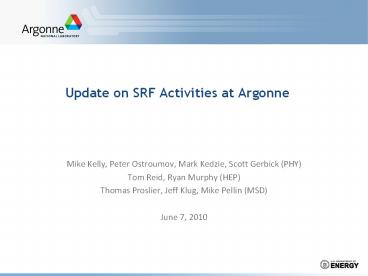Update on SRF Activities at Argonne - PowerPoint PPT Presentation
1 / 18
Title:
Update on SRF Activities at Argonne
Description:
Update on SRF Activities at Argonne Mike Kelly, Peter Ostroumov, Mark Kedzie, Scott Gerbick (PHY) Tom Reid, Ryan Murphy (HEP) Thomas Proslier, Jeff Klug, Mike Pellin ... – PowerPoint PPT presentation
Number of Views:128
Avg rating:3.0/5.0
Title: Update on SRF Activities at Argonne
1
Update on SRF Activities at Argonne
- Mike Kelly, Peter Ostroumov, Mark Kedzie, Scott
Gerbick (PHY) - Tom Reid, Ryan Murphy (HEP)
- Thomas Proslier, Jeff Klug, Mike Pellin (MSD)
- June 7, 2010
2
- ATLAS
- ILC
- National Security
- Atomic Layer Deposition
- SRF at the Advanced Photon Source (SC undulator
and crab cavity)
3
I. ATLAS Energy Upgrade Commissioned June
2009Exceeds previous state-of-the-art (at
TRIUMF) by 50
EP in Joint Facility
4
I. ATLAS Efficiency and Intensity Upgrade Phase
I RFQ and new cryomodule
- New 60.625 MHz CW RFQ
- New cryomodule with 7 QWRs ?OPT0.077
- Total 9.86M ARRA funds
- Complete in March 2013
5
I. ATLAS Energy and Intensity Upgrade
CryomoduleCommissioning in July 2012
(for scale)
6
I. Pushing performance for low-beta SRF cavities
b0.077 f72.5 MHz Bp/Eacc 4.8
mT/MV/m Ep/Eacc3.25
- Obvious benefits for ATLAS
- Replace aging split-ring cryomodules
- Higher energies (30-40 beam energy increase with
Phase I) - Higher intensities
- Real possibilities for high-gradient low-beta for
applications - National security (non-destructive interrogation
methods) - Nuclear medicine (accelerators as solution to
Mo99 crisis) - Renewed interest for waste transmutation
- To push for better performance in the intensity
upgrade - VCX fast tuner g Piezoelectric transducer 4 kW
coupler - Better performance through the use of techniques
learned in FNAL collaboration particularly
horizontal electropolishing on completed jacketed
niobium cavity
New center conductor die Courtesy AES, June 4,
2010
7
II. Joint ANL/FNAL Cavity Processing Facility
- Full operations (chemisty/clean room) since Mar
2009 - Two new EP operators trained
- Excellent single cell results, recent good 9-cell
results - Electropolishing system refinements
- Possible improvements still to be had in
operating parameters - Collaboration with JLab on KEK on EP optimization
Ultrasonic Cleaning
Electropolishing
High-pressure rinse
8
II. Cavities Electropolished/Assembled at the
ANL/FNAL SCSPF in 2010
Date Cavity Name Cavity Type EP Type Target Removal (µm) Process Run Time (min)
1/27/2010 TB9RI026 9-Cell Bulk 130 390
1/28/2010 TB9ACC007 9-Cell Light 20 70
2/15/2010 TB9RI026 9-Cell Heavy 100 300
2/18/2010 TE1ACC003 1-Cell Light 40 120
2/22/2010 TE1CAT002 1-Cell Bulk 120 360
3/26/2010 TB9RI024 9-Cell Light 20 70
3/30/2010 TB9RI026 9-Cell Light 20 70
4/2/2010 TB9AES003 1-Cell Light 20 70
4/7/2010 TE1CAT001 1-Cell Light 20 70
4/8/2010 NR-6 1-Cell Light 20 70
4/16/2010 TE1CAT001 1-Cell Light 30 100
4/20/2010 NR-6 1-Cell Light 30 100
4/28/2010 TB9RI029 9-cell Light 20 110
5/11/2010 TB9RI024 9-cell Light 20 120
5/25/2010 TB9RI020 9-cell Heavy 120 450
6/3/2010 TB9RI024 9-cell Light 20 100
9
II. Feedback from FNAL SRF Cavity Diagnostics
(KEK Camera) to ANL Cavity Processing
- Intra-grain structure is due to disruption of
viscous layer from acid injection - Cathode holes covered and orientation changed to
upward to reduce/remove this effect
10
II. New Low Voltage 9-cell cavity
electropolishing parameters
Cavity Temp.
Current
Voltage
Acid Temp.
Acid Temp.
Water Temp
Acid Flow
11
II. In the 2nd Chemistry Room QWR
electropolishing based on existing mechanical and
electrical hardware
rotating carbon brush assembly
sliding Bosch rail
12
II. Electropolishing for 650 MHz 5-cell cavity
- Scaled cavity geometry shown with the existing EP
hardware - Cavity with twice radial dimension of the 1.3 GHz
9-cell fits into the existing system with modest
modification (no cavity frame shown, may need to
shim under blue stands) - 55 gallon acid handling limit OK
- 2 ½ times surface area, EP supply OK, 50 larger
chiller - Cavity handling similar to 9-cell (crane in
hi-bay, hoist in chemistry room) - No major difficulties in adapting EP to this
geometry
13
III. SRF for National Security
- Accelerators for interrogation of special nuclear
materials - Based short high-intensity pulse of protons
- Secondary neutron production induces detectable
g-rays - Very high accelerator real estate gradients
needed (both low and high-b) - ANL-PHY funded to develop high real estate
gradients for low-b - Fabrication/processing/diagnostic technique to
achieve ILC type surface fields (120 mT) - Innovative design techniques to reduce surface
fields/increase packing factor
Concept for a stackable half-wave cavity with
very low surface fields
14
IV. Surface impedance Magnetic impurities the
residual resistance and more
Experimental evidence -Data courtesy JLab
(Ciovati) -Theory, Argonne Hot spots have higher
concentration of Magnetic impurities than cold
spots
Bake 120C
Bake 180C
3 parameters -e, a effect of Magnetic
impurities on the Nb superconductivity, give Rres
, ? and TC. Here e0.2 fixed. -Normal
conductivity s0 shift RST vertically, give the
mean free path L
15
IV. Surface impedance Magnetic impurities the
residual resistance and more
- Summary of results
- More magnetic impurities after baking (consistent
with Casalbuoni SQUID), Conc 200 ppm - Longer mean free path thus cleaner after baking.
- Smaller gap but larger ?/kTc after baking.
- Unknowns and next experiments
- Where are the magnetic impurities coming from
Oxides for sure but something else also? - EPR (electron paramagnetic resonance) to probe
mag. moments on EP samples. - -Refine the model introduce inhomogeneity or
surface layer.
16
IV. Superconducting layer by ALD
17
Thin films 10 nm
18
Summary SRF at ANL
- Phase I ATLAS Intensity Upgrade funded work
proceeding completion in 2013 - Cavity processing at the joint ANL/FNAL facility
- Good cavity throughput
- Tweaking chemistry and clean room techniques
based on test results and discussions with
JLab/KEK - Interest and support for SRF for non-basic
science applications - Material Science
- Atomic layer deposition to produce new
superconducting layers for cavities - Magnetic impurities to explain SRF properties of
niobium

